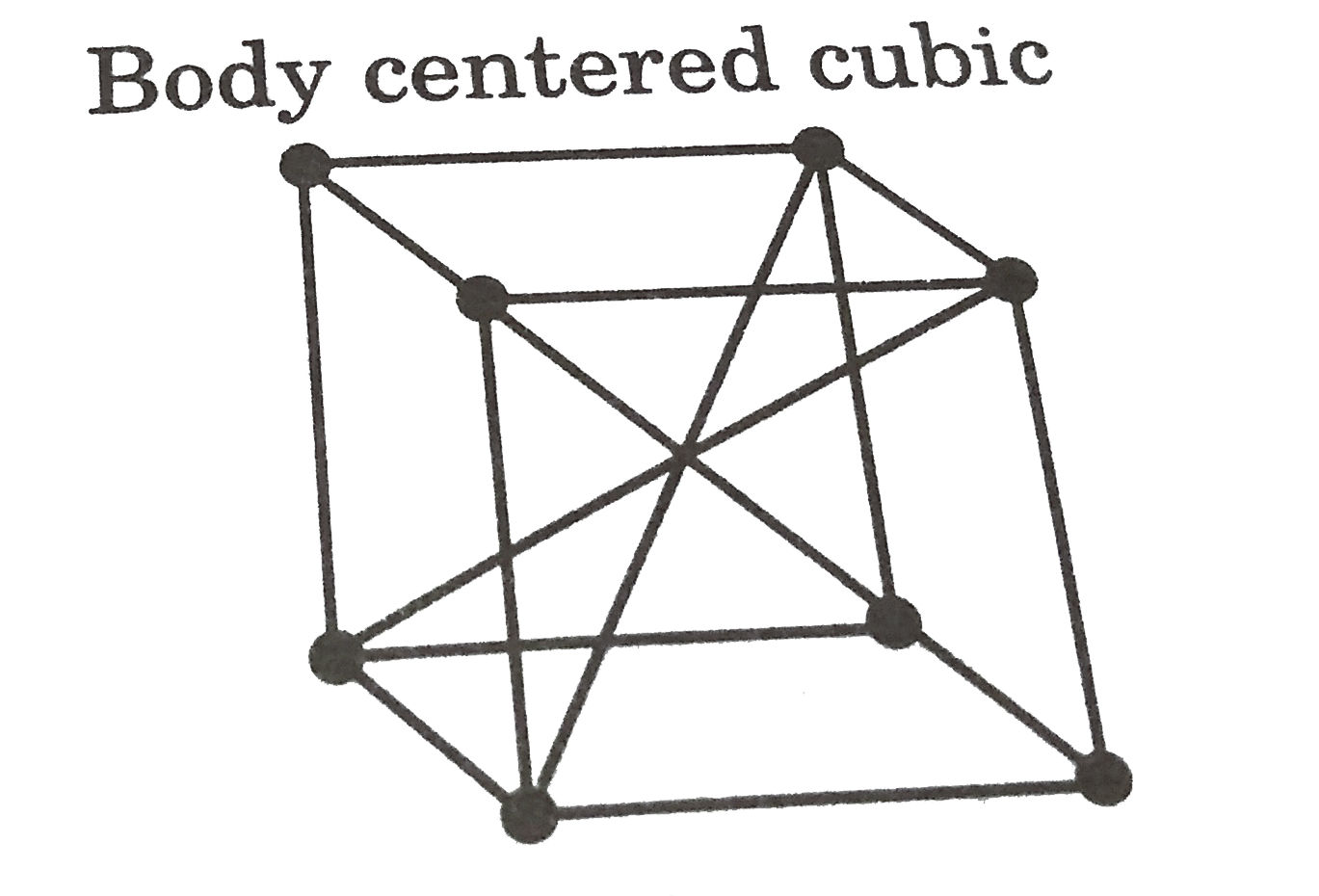Potassium iodide has cubic unit cell with cell edge of 705 pm. The density of KI is 3.12gcm−3. How many K+andI− ions are contained in the unit cell ?
The correct Answer is:4K+and4I−
To determine the number of K+ and I− ions contained in the unit cell of potassium iodide (KI), we can follow these steps:
Step 1: Convert the edge length from picometers to centimeters.
The edge length a is given as 705 pm. To convert this to centimeters:
a=705pm=705×10−12m=705×10−10cm=7.05×10−8cm
Step 2: Calculate the volume of the unit cell.
The volume V of the cubic unit cell can be calculated using the formula:
V=a3
Substituting the value of a:
V=(7.05×10−8cm)3=3.51×10−23cm3
Step 3: Use the density to find the mass of the unit cell.
The density ρ of KI is given as 3.12 g/cm³. The mass m of the unit cell can be calculated using the formula:
m=ρ×V
Substituting the values:
m=3.12g/cm3×3.51×10−23cm3=1.095×10−22g
Step 4: Calculate the molar mass of KI.
The molar mass M of potassium iodide (KI) can be calculated as follows:
- Molar mass of K = 39 g/mol
- Molar mass of I = 127 g/mol
M=39+127=166g/mol
Step 5: Calculate the number of formula units in the unit cell.
Using the formula relating mass, molar mass, and the number of formula units Z:
Z=m×NAM
where NA is Avogadro's number (6.022×1023mol−1).
Substituting the values:
Z=1.095×10−22g×6.022×1023mol−1166g/mol≈4
Step 6: Determine the number of K+ and I− ions in the unit cell.
Since each formula unit of KI contains one K+ ion and one I− ion, and we have determined that there are 4 formula units in the unit cell:
- Number of K+ ions = 4
- Number of I− ions = 4
Final Answer:
The unit cell of potassium iodide contains 4 K+ ions and 4 I− ions.
---
The edge length a is given as 705 pm. To convert this to centimeters:
a=705pm=705×10−12m=705×10−10cm=7.05×10−8cm
The volume V of the cubic unit cell can be calculated using the formula:
V=a3
Substituting the value of a:
V=(7.05×10−8cm)3=3.51×10−23cm3
The density ρ of KI is given as 3.12 g/cm³. The mass m of the unit cell can be calculated using the formula:
m=ρ×V
Substituting the values:
m=3.12g/cm3×3.51×10−23cm3=1.095×10−22g
The molar mass M of potassium iodide (KI) can be calculated as follows:
- Molar mass of K = 39 g/mol
- Molar mass of I = 127 g/mol
M=39+127=166g/mol
Using the formula relating mass, molar mass, and the number of formula units Z:
Z=m×NAM
where NA is Avogadro's number (6.022×1023mol−1).
Substituting the values:
Z=1.095×10−22g×6.022×1023mol−1166g/mol≈4
Since each formula unit of KI contains one K+ ion and one I− ion, and we have determined that there are 4 formula units in the unit cell:
- Number of K+ ions = 4
- Number of I− ions = 4
The unit cell of potassium iodide contains 4 K+ ions and 4 I− ions.
Topper's Solved these Questions
- SOLID STATEBOOK - MODERN PUBLICATIONCHAPTER - SOLID STATEEXERCISE - REVISION EXERCISES (NUMERICAL PROBLEMS)(CBSE Qs)
6 Videos
- SOLID STATEBOOK - MODERN PUBLICATIONCHAPTER - SOLID STATEEXERCISE - HOTS - HIGHER ORDER THINKING SKILLS (ADVANCED LEVEL)
12 Videos
- SOLID STATEBOOK - MODERN PUBLICATIONCHAPTER - SOLID STATEEXERCISE - REVISION EXERCISES (LONG ANSWER QUESTIONS)
6 Videos
- POLYMERSBOOK - MODERN PUBLICATIONCHAPTER - POLYMERSEXERCISE - Competition file (OBJECTIVE TYPE QUESTIONS) (C. MULTIPLE CHOICE QUESTIONS)(Integer Type Questions)
6 Videos
- SOLUTIONSBOOK - MODERN PUBLICATIONCHAPTER - SOLUTIONSEXERCISE - UNIT PRACTICE TEST
14 Videos
Similar Questions
Silver has a cubic unit cell with a cell edge of 408 pm. Its density is 10.6 g cm−3. How many atoms of silver are there in the unit cell? What is the structure of silver?
View SolutionAn element has a bcc structure with a celledge of 288 pm. The density of the element is 7.2gcm−3. How many atins are present in 208g of the element?
View Solution
Knowledge Check
An element has a body-centred cubic (bcc) structure with a cell edge of 288 pm. The density of the element is 7.2g/cm3. How many atoms are present in 208 g of the element?
A6.02×1024 atomsB12.09×1023 atomsC24.16×1023 atomsD29.88×1024 atomsFerrous oxide has a cubic structure. The length of edge of the unit cell is 5 Å. The density of the oxide is 4.0gcm−3. Then the number of Fe2+andO2− ions present in each unit cell will be
Afour Fe2+ and four O2−Btwo Fe2+ and two O2−Cfour Fe2+ and four O2−Dtwo Fe2+ and two O2−
KF has ccp structure. Calculate the radius of the unit cell if the edge length of the unit cell is 400 pm. How many F− ions and octahedral voids are there in the unit cell ?
View SolutionIron has a body centred cubic unit cell with a cell dimension of 286.65 pm. The density of irong is 7.874gcm−3. Use this information to calculate Avogardo's number ?
View SolutionThe edge length of NaCl unit cell is 564 pm. What is the density of NaCl in g/cm3?
View SolutionKF has ccp structure. Calculate the radius of the unit cell if the edge length of the unit cell is 400 pm. How many F− ions and octahedral voids are there in the unit cell ?
View SolutionMetallic sodium has a body-centred cubic unit cell. How many atoms are contained in one unit cell?

View SolutionKF has ccp structure . Calculate the radius of unit cell if the side of the cube or edge length is 400 pm . How many F ions and octahedral voids are there in this unit cell ?
View Solution
